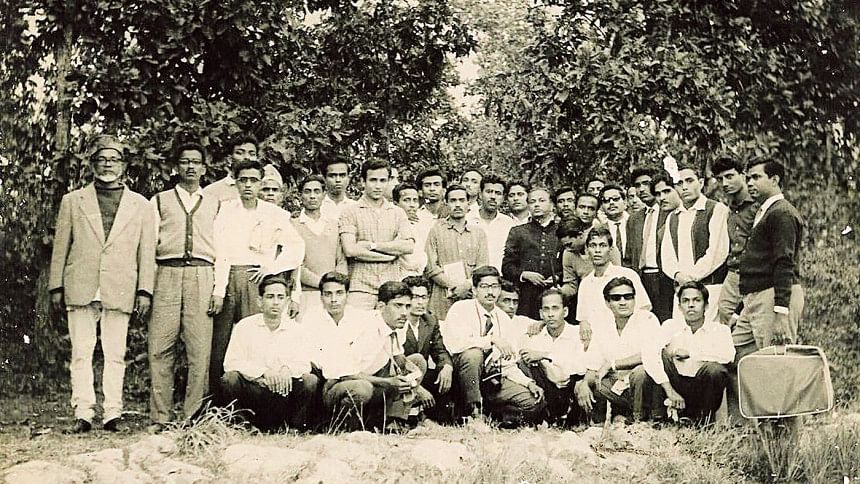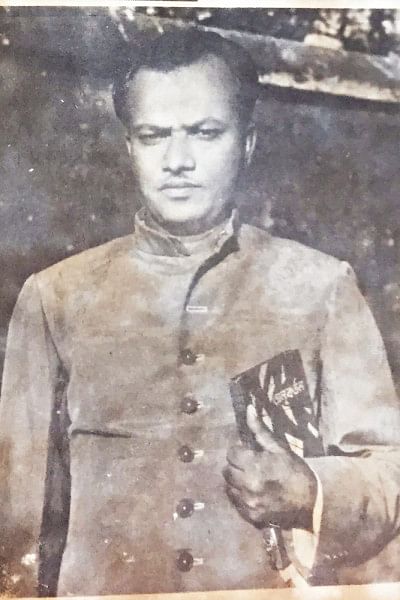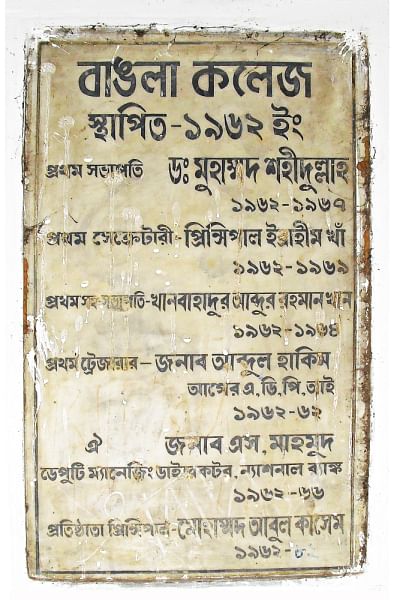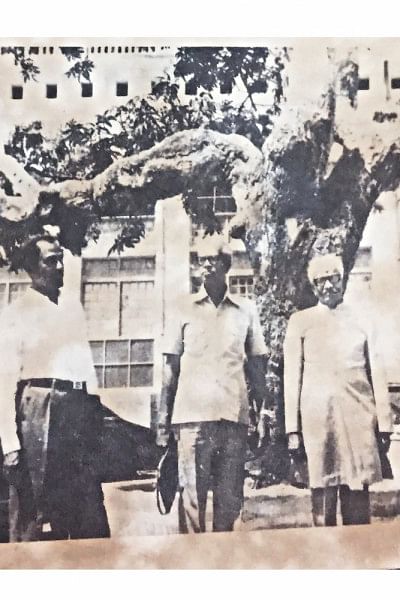Tale of Bangla College: Pioneering use of Bengali as a medium of higher education

On September 1, 1947, a group of students and faculty members at Dhaka University established Tamaddun Majlish, a cultural organization aimed at promoting the Bengali language. The organization addressed issues related to the status of Bengali as a state language by holding meetings and taking various initiatives. On September 15, they published a leaflet titled 'Pakistaner Rashtra Bhasha: Bangla na Urdu' to advocate for Bengali as the state language. Abul Quasem, a Physics professor at Dhaka University, drafted a language demand that Tamaddun Majlish published at the beginning of the book.

Principal Abul Quasem was a pivotal figure in advancing language-related matters, and his contributions played a critical role in the success of the institution, now famously known as Bangla College. In 1955, the Bangla Academy was established, as a continuation of the language movement that originated in 1952. Two years later, in 1957, the Bengali language was officially recognized, greatly increasing its value as a medium of instruction.
Mr. Quasem was a vocal proponent of the establishment of Bangla College and spoke passionately about it at Curzon Hall on two separate occasions - February 21, 1959, and again on February 21, 1961.
During a meeting, he stated: West Pakistan has made significant progress in its efforts to make Urdu the official language and medium of instruction by establishing the Urdu College many years ago. The Government of Pakistan has provided the Urdu College with substantial funds and territory. Despite numerous efforts, we have been unable to establish a Bangla College for the purpose of introducing Bengali at all levels. The government is equally silent on this issue. If the government fails to take action, we will soon establish a Bengali institution to promote the language.
The "Bangla College Preparation Committee" was formed to make the establishment of "Bangla College" a reality. The first meeting was held on February 15, 1961, at Bangla Academy, followed by additional sessions on February 19 and June 18 of the same year. During the meeting on February 19, Abul Quasem's proposal for the establishment of a Bangla College in Dhaka was overwhelmingly approved. This was viewed as a crucial first step towards establishing a Bangla University. A conference was held on March 4, 1962, at the Writers' Guild Bhavan on the grounds of Bangla Academy, paving the way for the formation of Bangla College. Most of the meetings were led by Dr. Muhammad Shahidullah and attended by notable figures such as Principal Ibrahim Khan, Khan Bahadur Abdur Rahman Khan, Poet Jasimuddin, Poet Golam Mostafa, and Abul Kalam Shamsuddin.
Dr Muhammad Shahidullah was elected as the first president of Bangla College, with Principal Ibrahim Khan serving as the general secretary. Khan Bahadur Abdur Rahman Khan (later Jagannath College Principal) was elected Vice-President, and former DPI Abdul Hakim was elected Treasurer.

Abul Quasem, an educator, served as the unpaid initial principal of the college. At the time of Bangla College's establishment, there were no Bengali textbooks available for higher studies. In order to promote Bengali as a medium of education and simplify the teaching of science, Mr. Quasem authored several Bengali Science textbooks and created more than a thousand new, easy-to-understand terms, which is a testament to his dedication and passion towards this cause.
In his book 'Amader Bhashar Roop' (The nature of our language, 1968), Abul Quasem's idea behind such an arduous effort is well-reflected, where he emphasizes that presenting knowledge and science in a simpler way makes them easier to understand. He also highlights the importance of avoiding unnecessary decorative language in books on science, as using such language can make the subject unclear and confusing, rendering the book ineffective. Science is meant to be comprehended, not just enjoyed like art and fiction. However, writers must still ensure that the language is straightforward, and the presentation is appropriate.
The establishment of 'Bangla College' was a challenging journey. In the initial years, the college principals, vice-principals, and professors had to teach without any pay. A few received minimal compensation, but most served without any remuneration. Abul Quasem, who played a significant role in the language movement, served as the college's principal for eight years without any pay. When the college authorities requested the allocation of a house from the government, the government agencies did not directly provide a suitable house. Abul Quasem searched for abandoned houses. However, the authorities rejected the college's request for a house in Dhanmondi, stating that the government had other plans for it. The college's request for a second house in Azimpur was also turned down, as it was intended to be purchased by an officer of the Agriculture Department.
After multiple unsuccessful attempts, Mr. Quasem eventually turned to his friend Abdul Mannan, who was the headmaster of Navakumar School in Bakhshi Bazar, for help. With Abdul Mannan's persuasion, the school administration agreed to allow "Bangla College" to operate as a night college in the Navakumar school building. The college officially began its activities at the Navakumar Institute in June-July 1962, and the first class was inaugurated in October of that year. The Science Department opened in the first year, followed by the Commerce and Humanities Departments in the second and third years, respectively.
Since there was no office space available in the Navakumar school building, Abul Quasem, who was the college principal, rented a furnished office on the ground floor of his apartment at 32/2 Azimpur for several years. Furnishings for the college were acquired through the help of friends, employees of the Majlis, and Dr. Muhammad Shahidullah, among others. After much persuasion, the college was granted the board's consent and university affiliation. However, the university administration denied the postgraduate degree.

According to Abul Quasem's memoir, the government was appealed to purchase a suitable location for the construction of Bangla College and Bangla University. However, after several fruitless attempts to find a site in Dhaka city, the decision was made to go for a dilapidated building in the then-forested area of Mirpur. The government was requested to obtain this property, but despite opposition from Bengali officers, the highest government committee during the Pakistani era approved the acquisition request in 1964. The university was allocated approximately 12 acres of land.
Assistance was sought from Mr Ferdaus Khan, a highly regarded mentor of Mr Quasem and then-director of the education department, to pay for the land and plan for the construction of Bangla College's campus. Mr Khan's efforts led to the government approving a significant amount of funding for the college's development. This funding was used to pay for the land in instalments and complete the construction of two floors of the main building, a portion of the dormitory, and a portion of the laboratory for the degree program. In 1969, after the partial completion of the college building, the day section was inaugurated, and classes began. B.Sc. and B.Com. classes commenced on October 4, 1969.
The establishment of Bangla College was supported by prominent newspapers of the time, such as Daily Ittefaq, Daily Azad, and Pakistan Observer. During this period, the Bengali-medium education system gained popularity and was implemented in many educational institutions.
Initially, some Bengali scholars strongly opposed the creation of Bangla College, arguing that students who learned through the Bengali medium would be at a disadvantage in the job market. Some even ridiculed the idea of establishing a "Bangla Maulbi." Despite this, the Bengali medium of instruction gained popularity quickly, and the performance of Bengali-medium students was quite satisfactory, with a pass rate significantly higher than that of government colleges at the time.
During the War of Liberation in 1971, the college was occupied by Pakistani forces and their non-Bengali Bihari collaborators, who replaced the college's signboard with another inscribed with "Urdu College" and closed it for the entire period of the war. After the war, the college started anew with fresh initiatives. In 1985, it was nationalized, and in 1997, Honours and Masters courses were introduced under the National University.
Hossain Muhammed Zaki is a Researcher. He can be contacted at [email protected]

 For all latest news, follow The Daily Star's Google News channel.
For all latest news, follow The Daily Star's Google News channel. 



Comments